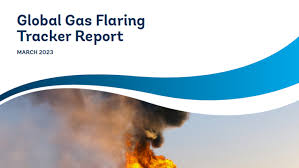Global Gas Flaring Tracker Report 2023:

As per the World Bank’s Global Gas Flaring Tracker Report, in 2023, the amount of gas flared worldwide rose by nine billion cubic meters (bcm) to 148 bcm, its highest level since 2019 .
- Gas flaring is the burning of the natural gas associated with oil extraction.
- The practice has persisted from the beginning of oil production over 160 years ago.
- It takes place due to a range of issues, from market and economic constraints, to a lack of appropriate regulation and political will.
- Flaring and venting are a waste of a valuable natural resource that should either be used for productive purposes, such as generating power, or conserved.
- Flaring persists to this day because it is a relatively safe, though wasteful and polluting, method of disposing of the associated gas that comes from oil production.
- The flare’s combustion converts hydrocarbons to carbon dioxide and water, which lessens the climate impact and reduces the safety concerns of the natural gas on site but also produces nitrogen oxides, or NOx.
- NOx—which includes the highly reactive gases nitric oxide and nitrogen dioxide—directly and indirectly impacts air quality.




